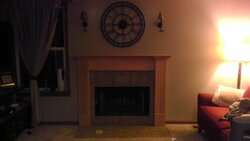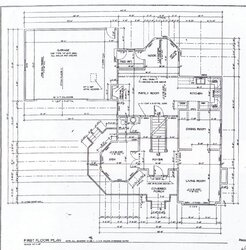Hello everyone, I'm new to the stove market, but definitely not new to burning as I'm a stationary engineer by trade. I was looking into an insert for out ZC superior. I soon realized that it would be better to go with a free standing stove. The plan is to demo the old zc and create an alcove out of the old chase. The old chase runs in my garage on the other side so my alcove size can really be any size. The house is a mid 90's built Victorian style with roughly 2500 sqft total (1400 main floor, 1100 second level). We have a large ceiling fan in the open foyer to pull heat upstairs. I have a few questions and i'll list them for easy answering. My plan is to go with something similar to geardoc and cwill's installs
1. Since my area that I plan to install in will be 8'HX5'WX3'D is this still considered an alcove? Most manufactures specify height is the issue.
2. In regards to getting the heat out of the alcove would it beneficial to slope the ceiling or blower in the ceiling behind a grate to roll the heat into the room?
3. I've been researching brands, But I keep coming to this point either they explicitly state alcove clearances, and some don't make mention at all. Which stove companies are alcove friendly and doesn't force a dealer network on the consumer?
4. What will dictate me for using stove pipe from the stove until the first firebreak? If I have to use doublewall is that the same as the class a ill have to run from the first firebreak until my cap? the total flue length will be roughly 25ft
5. How does one brush from top to bottom when most of these stoves have a baffle plate?
6. I've been looking into used stoves to keep the initial cost down, Because I believe a safe chimney and hearth is more important, and I can upgrade a stove easier later on. What are things to look for in the used stove market?
7. Would a firebox in the 2.2 cu ft range be ideal? enclosed is a floor plan and the real picture of the family room. Your suggestions and comments are welcome


1. Since my area that I plan to install in will be 8'HX5'WX3'D is this still considered an alcove? Most manufactures specify height is the issue.
2. In regards to getting the heat out of the alcove would it beneficial to slope the ceiling or blower in the ceiling behind a grate to roll the heat into the room?
3. I've been researching brands, But I keep coming to this point either they explicitly state alcove clearances, and some don't make mention at all. Which stove companies are alcove friendly and doesn't force a dealer network on the consumer?
4. What will dictate me for using stove pipe from the stove until the first firebreak? If I have to use doublewall is that the same as the class a ill have to run from the first firebreak until my cap? the total flue length will be roughly 25ft
5. How does one brush from top to bottom when most of these stoves have a baffle plate?
6. I've been looking into used stoves to keep the initial cost down, Because I believe a safe chimney and hearth is more important, and I can upgrade a stove easier later on. What are things to look for in the used stove market?
7. Would a firebox in the 2.2 cu ft range be ideal? enclosed is a floor plan and the real picture of the family room. Your suggestions and comments are welcome



